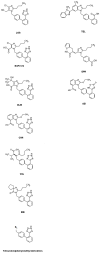Suppression of adrenal βarrestin1-dependent aldosterone production by ARBs: head-to-head comparison
- PMID: 25631300
- PMCID: PMC4309955
- DOI: 10.1038/srep08116
Suppression of adrenal βarrestin1-dependent aldosterone production by ARBs: head-to-head comparison
Abstract
The known angiotensin II (AngII) physiological effect of aldosterone synthesis and secretion is mediated by either Gq/11 proteins or βarrestin1 (βarr1), both of which can couple to its type 1 receptors (AT₁Rs), present in adrenocortical zona glomerulosa (AZG) cell membranes. In the present study, we examined the relative potencies of all the currently used in the clinic AT₁R antagonist drugs (angiotensin receptor blockers, ARBs, or sartans) at preventing activation of these two signaling mediators (G proteins and βarrs) at the AngII-bound AT1R and, consequently, at suppression of aldosterone in vitro. All ARBs were found to be potent inhibitors of G protein activation at the AT₁R. However, candesartan and valsartan were the most potent at blocking AngII-induced βarr activation at this receptor, among the tetrazolo-biphenyl-methyl derivatives, translating into excellent efficacies at aldosterone suppression in H295R cells. Conversely, irbesartan and losartan were largely G protein-selective inhibitors at the AT₁R, with very low potency towards βarr inhibition. As a result, they were very weak suppressors of βarr1-dependent aldosterone production in H295R cells. These findings provide important pharmacological insights into the drug class of ARBs and medicinal chemistry insights for future drug development in the field of AngII antagonism.
Figures







References
Publication types
MeSH terms
Substances
Grants and funding
LinkOut - more resources
Full Text Sources
Other Literature Sources
Research Materials

